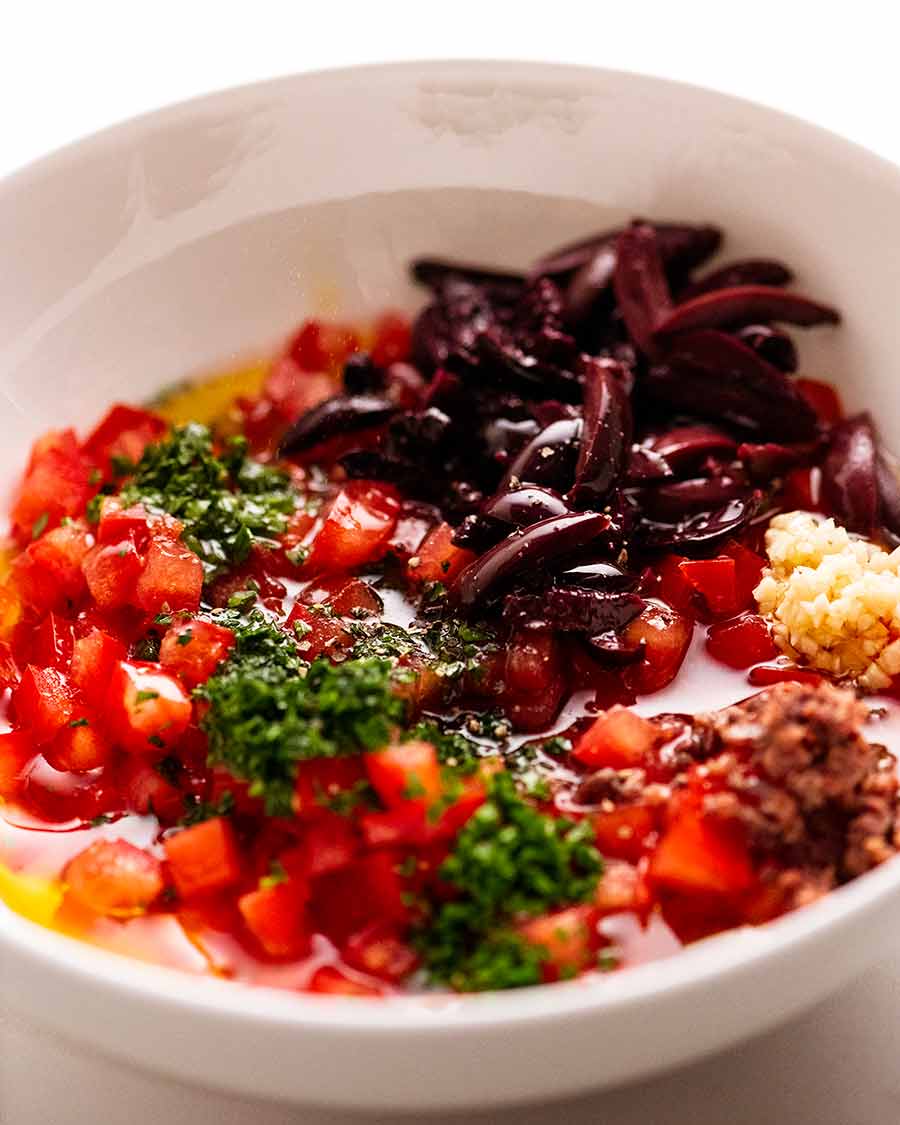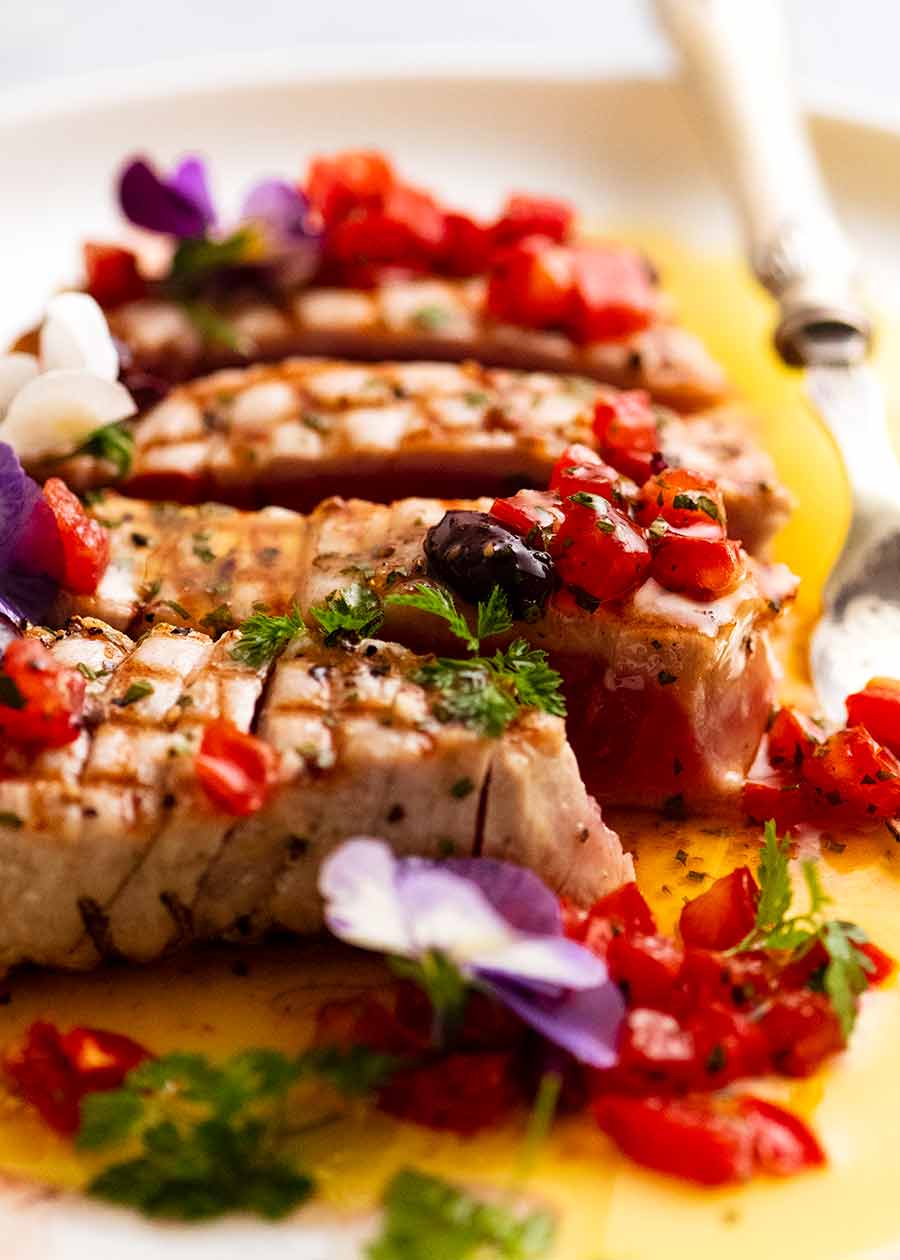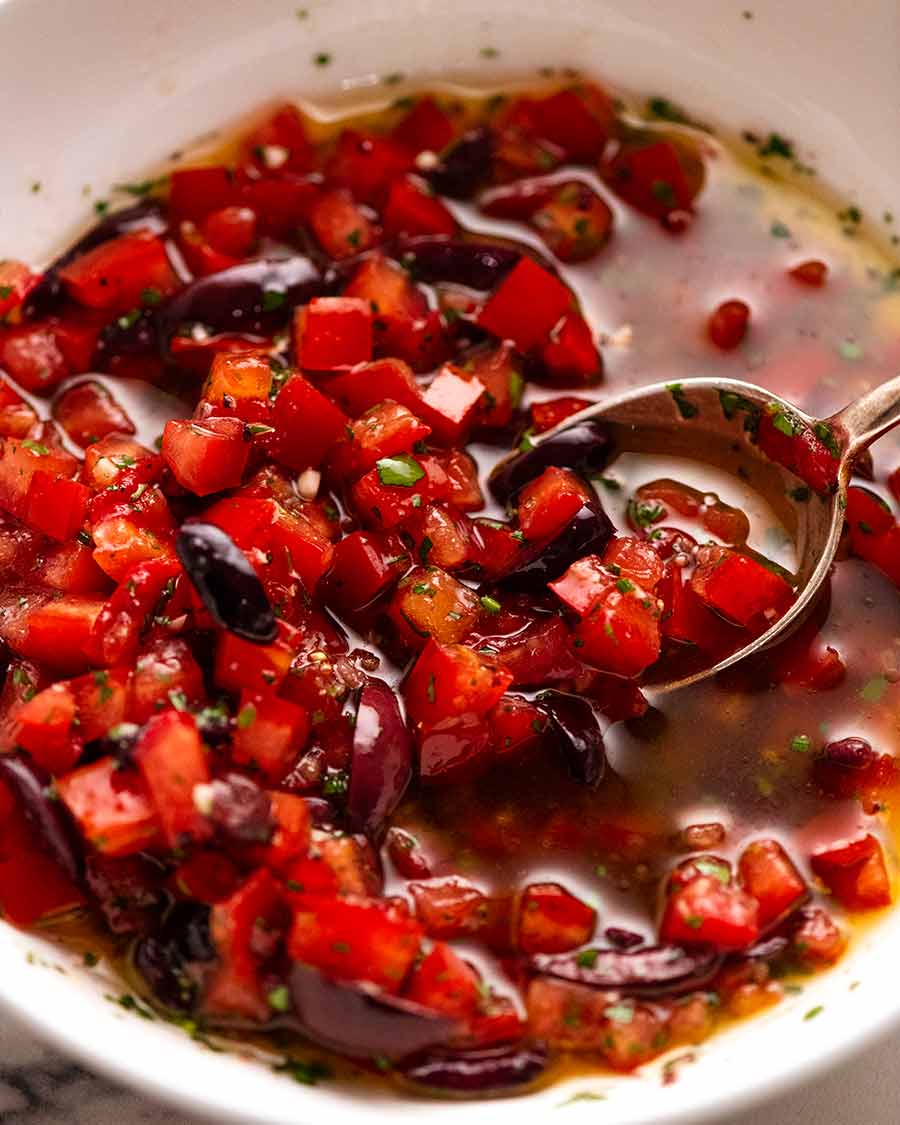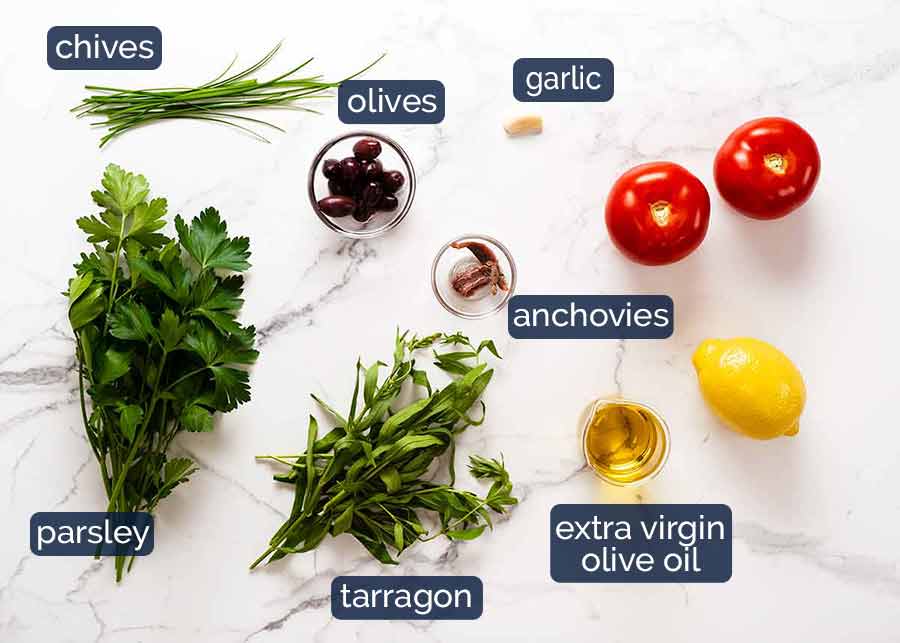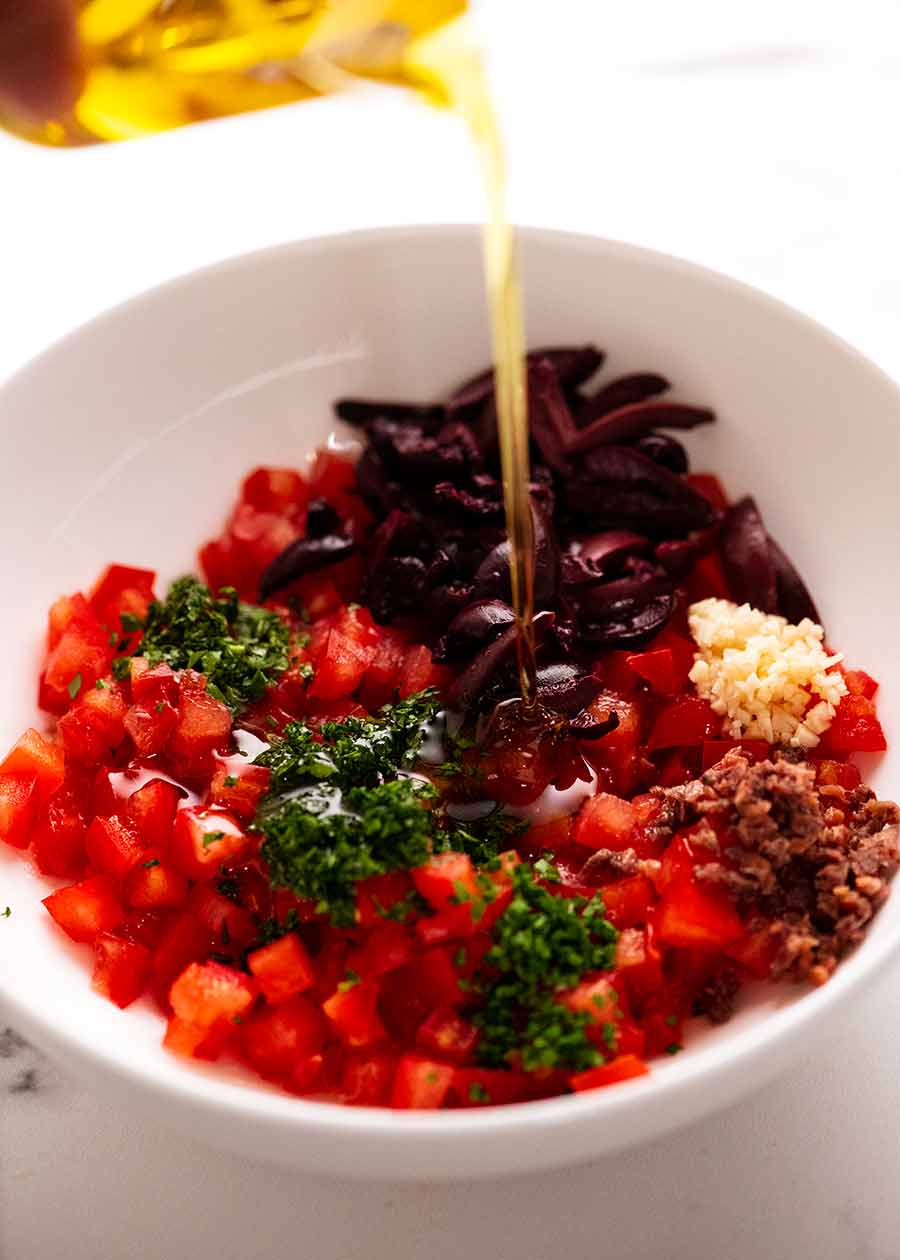Its use doesn’t end with seafood though! Also serve it with chicken, pork or vegetables. You could also use as a salsa dip, or pile it on toasted bread to make simple bruschetta or crostini. Try it also over a omelette or frittata, or corn fritters! Even twirl pasta through it!
Sauce Vierge – a classic sauce for fish!
I featured Sauce Vierge in my Tuna Steak recipe which I also published today. However this is such a terrifically versatile sauce that I decided to publish it separately so you can explore the fullest extent of its possibilities!
What is Sauce Vierge?
Sauce Vierge is a French sauce made from finely diced tomatoes, olive oil, fresh herbs and a touch of lemon juice for freshness. It’s a no-cook sauce, sort of like a salsa, and is light and summery in both taste and appearance. Sauce Vierge translates to “Virgin Sauce”, I guess a reference to the clean and pure character of the sauce? 😉 Sauce Vierge was popularised by Michel Guérard, a French chef who championed a new style of French food in the 1970’s called nouvelle cuisine (literally, “new cuisine”). This movement resisted the classical traditions of French cooking, instead emphasising freshness, simplicity, and lighter treatments that flattered ingredients. This extended to the visual with greater attention given to colour, naturalism and elegant presentations compared to traditional haute cuisine. Really, this sauce couldn’t be a better expression of this new school of French food thought!
What Sauce Vierge tastes like
It’s essentially a salsa, with summery Mediterranean ingredients and flavours. It gets a hit of complexity and depth with the addition of anchovy fillets and a mix of fresh herbs. Richness and body comes from the extra virgin olive oil. For such a simple sauce, try to use the best oil you can afford for the best flavour!
What goes in Sauce Vierge
There are all sorts of versions around, but essentially the core ingredients in it are fresh tomato, olive oil and fresh herbs along with a touch of acidity, usually from lemon. This version I’m sharing today is pretty classic, with a lovely mix of fresh herbs. I also add olives and anchovies for a little extra umami and depth which makes this sauce even more versatile.
Tomatoes – They’ve got to be ripe and juicy! They are a key ingredient here so make sure they’re good ones;Anchovies – Though perhaps not strictly traditional, this is a key ingredient in mine that gives this otherwise simple sauce a terrific depth of flavour and natural savouriness. Without it, some people would probably consider this sauce a bit plain, or missing “something”. It’s the main salt in this dish. It does not taste fishy at all. In fact, you can’t even tell it’s in there and more adds what the French would call a little je ne sais quoi !Can’t do anchovy?? Use one of the following substitutions:– Best alternative: 1/2 tsp fish sauce + pinch of extra salt (leave Sauce Vierge for 20 minutes to let flavour meld)– Other option: 1/4 tsp Worcestershire + extra salt (non-fish substitute)Fresh herbs – Herbs add freshness, flavour and colour. I like a combination of herbs to add interest. Parsley, chives and tarragon I find is a beautiful mix. (Other herbs that would work well include basil and chervil.) If you don’t have all 3, use just parsley, or half parsley and half tarragon;Olives – Like anchovies, olives are perhaps not strictly traditional but bring this sauce an extra dimension that makes it all the more versatile. Lovely little pops of salty juicy goodness, the olives give this sauce a more distinctly Mediterranean feel and flavour for me, as well as adding striking glistening pops of black throughout the red;Garlic – Just a hint, not too much;Lemon juice – The fresh tang in the sauce. If you don’t have lemons, use white or red wine vinegar instead. There are versions of Sauce Vierge that opt for vinegar, but I love the fresh flavour of lemon; andExtra virgin olive oil – Use the best you can afford, for the best flavour!
To make, simply combine all ingredients and mix! Sometimes Sauce Vierge is slightly warmed to serve with hot foods. To do this, gently heat the sauce in a small pot for a few minutes to just warm through and encourage the flavours to marry. Don’t boil it or you’ll lose all that wonderful freshness! Can’t do anchovy?? Use one of the following substitutions:– Best alternative: 1/2 tsp fish sauce + pinch of extra salt (leave Sauce Vierge for 20 minutes to let flavour meld)– Other option: 1/4 tsp Worcestershire + extra salt (non-fish substitute)
What to serve with Sauce Vierge
This light and fresh, no-cook sauce is particularly good with seafood, but don’t stop there! Here are some more suggestions:
Fish and shellfish – Spoon it over like a salsa;Chicken or pork – Pan-sear meat with just salt and pepper, then spoon over Sauce Vierge;Vegetables – Great served over lightly barbecued or steamed vegetables.Salsa-type dip – For scooping up with corn chips or homemade crostini!Spooned over omelettes or a frittata. Or try it with an Egg White Omelette!Pile onto toasted bread to make bruschetta or crostini;With corn fritters! This would be 100% sensational.With pasta – What the Italians would call an “uncooked” pasta sauce. Simple boil pasta, toss through the Sauce Vierge.
So there’s just a few ideas to get you started! If you make it, let me know what else you used it for – share it with everyone in the comments below! – Nagi x PS. No video for this one because it’s a quick bonus recipe today. But if you really want one, let me know in the comments below!
Life of Dozer
Just a little snack – munching on the grass at the park!
